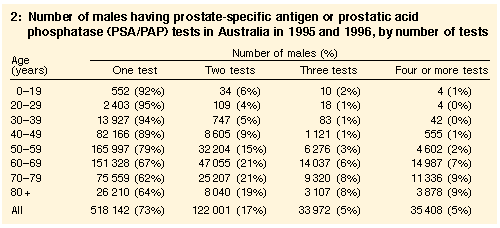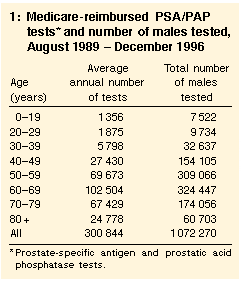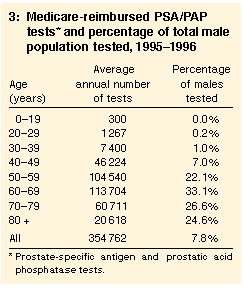Prostate-specific antigen testing in Australia and association with prostate cancer incidence in New South Wales
David P Smith and Bruce K Armstrong
MJA 1998; 169: 17-20
For editorial comment, see McCredie & Cox
Abstract -
Introduction -
Methods -
Results -
Discussion -
Acknowledgements -
References -
Authors' details
-
-
©MJA1998
Abstract |
Objective: To describe patterns and trends in
prostate-specific antigen (PSA) testing in Australia and assess its
role in the increasing incidence of prostate cancer. Design: Descriptive analysis of (i) Medicare records of PSA testing in Australia, and (ii) prostate cancer recorded incidence in New South Wales. Data: (i) Medicare data for all males who received a Medicare-reimbursed PSA test between August 1989 and December 1996. (ii) NSW Central Cancer Registry data for all males in NSW with prostate cancer diagnosed between 1988 and 1995. Main outcome measures: (i) Number of PSA tests, age-standardised rates of PSA tests by State and Territory, and proportions of males who had a PSA test. (ii) Recorded incidence of prostate cancer in NSW. Results: (i) More than 2.2 million PSA tests were done on more than 1.1 million Australians between 1989 and 1996. The annual number of males tested increased fivefold in this period and peaked in 1995. Twenty-seven per cent of Australian men aged 50 years or over had at least one PSA test in 1995 or 1996; 33% of men aged 60-69 years had a test in this period. (ii) In NSW the number of PSA tests per quarter was highly correlated with the number of new cases of prostate cancer (R2 = 0.92). Conclusions: Although no organised program for prostate cancer screening exists, and despite repeated advice against it, opportunistic screening has been occurring at high rates. There was a high correlation between PSA testing and prostate cancer incidence between 1990 and 1995 in NSW. |
Introduction |
Prostate cancer is the most common cancer in Australians after
non-melanocytic skin cancers, and accounts for about a third of all
newly diagnosed internal cancers in males.1,2 It is the second most common cause
of cancer death among Australian males.3 During the late 1980s and early
1990s, recorded prostate cancer incidences increased
substantially in Australia, while mortality from prostate cancer
remained stable.1,2,4-6
Much of the increase in incidence has been attributed to detection of
latent cancers by increased use of the prostate-specific antigen
(PSA) test, transurethral resection of the prostate, prostatic
biopsy and radical prostatectomy.7 There are considerable arguments for8,9 and against10,11 screening for prostate cancer. In 1996 the Australian Health Technology Advisory Committee reviewed the evidence and recommended against screening. However, the committee recognised that de facto screening occurs in the community and stated a need to monitor and review the evidence when important developments occur.12 Data collected by the Health Insurance Commission provide the best available means to monitor trends and patterns in PSA testing. We analysed these data to determine the association between PSA testing and reported incidence of prostate cancer in Australia and in New South Wales. |
Methods | |
Data |
PSA tests: The Commonwealth Department of Health and Family Services Medicare Estimates and Statistics Unit provided de-identified data, extracted from the national dataset of all services rendered on a fee-for-service basis for which a Medicare benefit has been paid. The data included all tests itemised under the Medicare Benefits Schedule codes that included PSA tests. PSA tests first appeared in the Schedule in August 1989, but were included with 20 "other" biochemical tests until November 1993. Since then they have been itemised together with prostatic acid phosphatase (PAP) tests. PSA tests could not be differentiated from PAP tests with the available information. To estimate the proportion of non-PSA tests in the dataset, we investigated the patterns of use of the other tests, using data provided by the Commonwealth Department of Health and Family Services. We calculated retrospective projections using exponential regression on the number of tests by age group and annual quarter to give an adjusted number of PSA and PAP tests for the period between August 1989 and November 1993. This study included data for all males who had at least one PSA or PAP test between 1989 and 1996 reimbursed by Medicare. The data included a unique identification number for each person, age, date of service, postcode, and fee charged for the service. The identification number allowed individuals to be linked over time to quantify those who had multiple tests, but was not linkable to any other identifying data. Prostate cancer: Data on prostate cancer incidence in NSW were obtained from the NSW Central Cancer Registry, a population-based register which began collecting data in 1972. Notification of malignant neoplasms has been a statutory requirement for all NSW public and private hospitals, radiation oncology departments and nursing homes since 1972, and for all pathology and outpatient departments since 1985.1 Population: The Australian Bureau of Statistics provided the estimated resident populations of Australia by five-year age group and State or Territory for the years 1989 to 1996.13 |
Analysis |
We calculated the rate of testing and the number of males tested by age
group, State or Territory, and year from August 1989 to December 1996.
We calculated the number of males having multiple tests from January
1995 to December 1996 and the proportion of males tested in each age
group in this period. We used a two-year period for these calculations
to reduce errors introduced by men moving up age groups.
We compared the number of tests carried out in NSW by quarter with the number of prostate cancers diagnosed between 1990 and 1995 (the most recent year for which prostate cancer data were available). All rates, standardised to the total male and female Australian 1991 population, are expressed per 100 000 males. We used SAS software for statistical analysis.14 |
Results | |
PSA testing in Australia |
From August 1989 to December 1996 more than 2.2 million PSA or PAP tests
were reimbursed by Medicare in Australia. About 1.1 million males
were tested during this period. Eighty-eight per cent of the tests
were for men aged 50 years or over, with the largest proportion (34%)
for men aged 60-69 years (Table 1).
Age-standardised rates for males having one or more PSA/PAP tests per year increased fivefold between 1990 and 1996, and the greatest increases occurred between 1993 and 1995. There was substantial variation in the rates of testing by State and Territory (Figure 1). Except in the Australian Capital Territory, the rates peaked in 1995, when the highest rates were in Western Australia (8668 tests per 100 000) and the Australian Capital Territory (8284 tests per 100 000) and the lowest in the Northern Territory (3270 per 100 000).
From January 1995 to December 1996, 709 523 Australian males had at least one PSA/PAP test reimbursed by Medicare. Most of those tested (73%) had one test, 17% had two tests, 5% had three tests and 5% had four or more tests. Older men were more likely to have had multiple tests (Table 2). |
 | |
In this period, 27% of Australian men aged 50 years and over had one or more PSA/PAP tests reimbursed by Medicare. This figure peaked at 33% in men aged 60-69 years (Table 3).
In 1996 the Medicare schedule fee for a single PSA/PAP test was $19.90 or, where two or more tests were undertaken at the same consultation, $36.65. The overall amount reimbursed by Medicare for PSA/PAP tests in 1996 was $10 675 880 (mean per test, $20.73; mode, $19.90; range, $11.00 to $36.65), not including the fee that may have been charged for the accompanying consultation. | |
PSA/PAP tests and prostate cancer in NSW |
Between 1990 and 1995, more than 625 000 PSA/PAP tests were carried out
in NSW, and 20 120 prostate cancers were diagnosed. The number of tests
was highly correlated with the number of prostate cancers diagnosed
(R2 = 0.92)
(Figure 2). The ratio of number of tests
performed to number of new cases of prostate cancer diagnosed
increased from about 19 in 1990 to 45 in 1995.
In 1995, in NSW, 150 479 males had one or more PSA/PAP tests. Figure 3 shows the age-specific rates of testing and reported incidence of prostate cancer. The number of PSA/PAP tests per prostate cancer detected in 1995 varied between age groups from a high of 579 in men aged 40-49 years to fewer than 24 in men aged 70 years or over. |
Discussion |
More than 2.2 million PSA tests were carried out in Australia from 1989
to 1996. More than 1.1 million males were tested in this period, and the
annual number of males tested peaked in 1995. Data from this study
support the hypothesis that the rising incidence of prostate cancer
is associated with increased PSA testing. In NSW, the number of PSA
tests was highly correlated with the number of new cases of prostate
cancer.
The PSA test is a blood test used in diagnosis and monitoring of prostate disease. First used in Australia in the late 1980s to monitor clinically identified disease, it has since been used in the diagnosis of relevant symptoms and as a screening test for asymptomatic men. It was not possible to identify from Medicare data the reasons why the tests were ordered. However, recent research found that 67 of 118 PSA tests (57%) were ordered for screening.15 Although we adjusted for other tests included under the same Medicare Benefits Schedule item from 1989 to 1993, we could not adjust for PAP tests, which are used to monitor the clinical progress of prostate cancer. However, in a continuous six-month period the ratio of PAP tests to PSA tests processed by a large, representative private pathology laboratory in NSW (covering city, suburban and regional centres) was less than 2% (Dr G Caldwell, Pathologist, Douglass Hanly Moir Pathology, personal communication). Data from a large public pathology laboratory in South Australia indicate that the proportion of PAP tests to the total PSA and PAP tests fell from 50% in 1991 to 6% in 1996 (Dr H A Morris, Manager, Endocrine Unit, Institute of Medical and Veterinary Science, personal communication). At their peak in 1995, the rates of PSA/PAP testing in Australian males ranged from 3270 per 100 000 in the Northern Territory to 8668 per 100 000 in Western Australia. These are probably underestimates because Medicare data do not include services provided free to public patients in public hospitals, to Veterans' Affairs patients and to men offered screening under the research activities of centres such as the Perth-based Urological Research Centre. In the one-year period April 1993 to March 1994, 39 626 PSA tests were done on 30 739 veterans.16 Data from the Department of Veterans' Affairs show about 50 000 tests were done each year in Australia between 1994 and 1996, which would have contributed a further 10% to the number of Medicare-reimbursed PSA tests. In South Australia 72 000 PSA tests that would not appear in Medicare statistics were undertaken between 1990 and 1996 by a public laboratory (Dr H A Morris, personal communication). These and the tests done on veterans would have accounted for an approximate under-enumeration of 33% annually in South Australia. Nationally, considering all these extra sources of PSA tests, we estimate that Medicare data underenumerate PSA tests by 14%. In a recent study of self-reported rates of prostate cancer screening in the Central Sydney Area Health Service, about one in five men aged 50 years or over reported being screened in the previous 12 months.17 This agrees quite closely with our results, which show that during the two years 1995 to 1996 about one in four Australian men aged 50 years or over had a PSA test, and in 1995 one in six (17%) had a test. More prostate cancers would result in more PSA tests used for monitoring. However, the overall effect of this on PSA test-ordering is thought to be small. More than 70% of males tested in 1995 and 1996 had only one test, suggesting that most tests were for screening rather than monitoring disease activity. A further possible indication that most tests were undertaken for screening rather than for monitoring or diagnosis is the increase in the ratio of tests to newly diagnosed prostate cancers in New South Wales. This ratio continued to increase in 1995, when the reported incidence of prostate cancer had begun to fall. Increasing recorded incidences of prostate cancer have been reported from the United States,18-22 France23 and elsewhere in Australia.1,2,4-6 Incidence figures began rising earlier in the United States than in Australia, and appeared to peak in 1992 and 1993.20 South Australian and Western Australian age-standardised recorded incidences peaked in 1994 and fell by 22% and 13%, respectively, between 1995 and 1996.2,4,5 The rate of PSA testing peaked in 1995 in both States and fell 10% and 16%, respectively, in 1996. These data and the high correlation between PSA tests and newly diagnosed prostate cancers in NSW support the hypothesis that the rising incidence figures for prostate cancer in the early 1990s were a direct result of screening.7 Based on these trends and correlations, it is likely that the recorded incidence for prostate cancer in most Australian States and Territories will continue to fall after 1995. Given that screening for prostate cancer has never been recommended in Australia, the rates of de facto screening in men aged over 50 years, and especially those aged between 60 and 69 years, are quite remarkable. These findings have important implications for public health policy and for patient and practitioner education aimed at reducing prostate cancer screening. |
Acknowledgements | We would like to thank Mr Ross Saunders, Director of the Medicare Statistics Section of the Department of Health and Family Services, for supplying the data. |
References |
(Received 28 Nov 1997, accepted 24 Apr 1998) |
Authors' details
Cancer Control Information Centre, New South Wales Cancer Council, Sydney, NSW.David P Smith, BA, MPH, Research Coordinator, Cancer Epidemiology Research Unit;
Bruce K Armstrong, DPhil, FRACP, Director.
Reprints will not be available from the authors.
Correspondence: Mr D
P Smith, Cancer Epidemiology Research Unit, NSW Cancer Council, PO
Box 572, Woolloomooloo, NSW 2011.
E-mail: dsmithATnswcc.org.au
Readers may print a single copy for personal use. No further reproduction or distribution of the articles should proceed without the permission of the publisher. For permission, contact the Australasian Medical Publishing Company
Journalists are welcome to write news stories based on what they read here, but should acknowledge their source as "an article published on the Internet by The Medical Journal of Australia <http://www.mja.com.au>".
<URL: http://www.mja.com.au/>
Received 8 April 2025, accepted 8 April 2025









